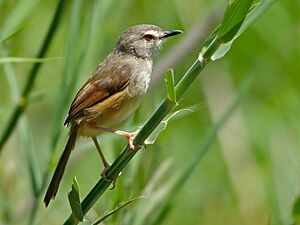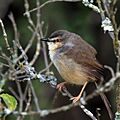Tawny-flanked prinia facts for kids
Quick facts for kids Tawny-flanked prinia |
|
|---|---|
 |
|
| Conservation status | |
| Scientific classification | |
| Genus: |
Prinia
|
| Species: |
subflava
|
The tawny-flanked prinia (scientific name: Prinia subflava) is a small, active bird found across much of Africa south of the Sahara desert. It belongs to a group of birds called passerines, which are often called "perching birds." This little bird is part of the Prinia genus, and its family, Cisticolidae, includes many Old World warblers. It's a very common bird in its habitat.
Scientists used to think the plain prinia (P. inornata) from southern Asia was the same species. However, they now consider it a separate type of prinia.
Contents
About the Tawny-flanked Prinia
How Scientists Name Birds
The tawny-flanked prinia was first officially described in 1789 by a German naturalist named Johann Friedrich Gmelin. He gave it the scientific name Motacilla subflava. The word subflava means "somewhat yellow" in Latin, which describes the bird's colors.
Later, in 1821, an American naturalist named Thomas Horsfield created the genus Prinia. The tawny-flanked prinia is now one of about 30 species in this genus.
Different Types of Tawny-flanked Prinias
There are ten different types, or subspecies, of the tawny-flanked prinia. These subspecies are slightly different from each other, often in their size, color, or where they live. Here are the recognized subspecies:
- P. s. subflava (Gmelin, JF, 1789) — Found from south Mauritania and Senegal to central Ethiopia and north Uganda.
- P. s. pallescens (Madarász, G, 1914) — Lives from north Mali to northwest Eritrea and north Ethiopia.
- P. s. tenella (Cabanis, 1868) — Found in south Somalia, east Kenya, and east Tanzania.
- P. s. melanorhyncha (Jardine & Fraser, 1852) — Lives from Sierra Leone to south Uganda, central Kenya, and northwest Tanzania.
- P. s. graueri (Hartert, EJO, 1920) — Found in central Angola, south, east DR Congo, and Rwanda.
- P. s. affinis (Smith, A, 1843) — Lives from southeast DR Congo and southwest Tanzania to northeast South Africa.
- P. s. kasokae (White, CMN, 1946) — Found in east Angola and west Zambia.
- P. s. mutatrix (Meise, 1936) — Lives from south Tanzania to east Zimbabwe and central Mozambique.
- P. s. bechuanae (Macdonald, 1941) — Found from southwest Angola and north Namibia to northwest Zimbabwe.
- P. s. pondoensis (Roberts, 1922) — Lives in south Mozambique and east South Africa.
What Does it Look Like?
The tawny-flanked prinia is a small bird, about 11 to 12 centimeters (around 4 to 5 inches) long. It has a long, thin tail that often sticks straight up or wags from side to side. Its beak is also quite long and slender.
Colors and Markings
The top part of its body is grey-brown. Its flight feathers (the long feathers on its wings) have reddish-brown edges. The area above its tail, called the rump, also has a reddish color.
The bird's throat and chest are whitish. Its sides and the area under its tail are a warm, light brown color. It has a whitish stripe above its eye, and the area between its eye and beak is dark. The tail feathers have a white tip with a dark band just before the tip.
Differences Between Birds
Both male and female tawny-flanked prinias look very similar. Birds that are not breeding have a longer tail than those that are breeding. Young prinias, called juveniles, have pale yellow underparts and a yellowish beak.
Sounds and Songs
The call of this bird is short, wheezy, and repeated very quickly. Its song is a simple series of high-pitched notes that sound the same over and over. The male prinia often sings from a high, open spot where it can be easily seen.
Similar Birds
The pale prinia (P. somalica) from North-east Africa looks similar but is lighter and more grey. It also has whitish sides. This bird lives in drier, more open areas than the tawny-flanked prinia. Another similar bird is the river prinia (P. fluviatilis) from West Africa. It is also paler and greyer with a longer tail, but it only lives near water.
Where it Lives and Its Home
Distribution Across Africa
The ten different subspecies of the tawny-flanked prinia live across most parts of sub-Saharan Africa. They are not found in the very driest or wettest areas. For example, you won't find them in much of the Congo Basin, southern Namibia, southwest Botswana, or the western half of South Africa.
Preferred Habitats
This bird likes to live among shrubs and grass. You can find it in many different places, including woodlands, savannas (grassy plains with scattered trees), and even in areas where people grow crops. It adapts well to places changed by humans. Because it is so common and can live in many different environments, it is not considered to be in danger.
Life and Habits
What it Eats
The tawny-flanked prinia mainly eats insects and other small invertebrates (creatures without backbones). It usually searches for food in small groups, moving through bushes and low plants.
Reproduction and Nesting
The nest of the tawny-flanked prinia is shaped like a small bag or purse. It is carefully made from strips of grass woven together. The bird builds its nest about one to two meters (around 3 to 6 feet) above the ground.
Female prinias usually lay two to four eggs. The eggs can be different colors, but they usually have brown or purple spots or blotches on them.
Images for kids
-
P. s. bechuanae with nesting material, Namibia
-
Juvenile P. s. melanorhyncha, Soysambu Conservancy, Kenya
-
Collecting nest material in Kruger National Park





